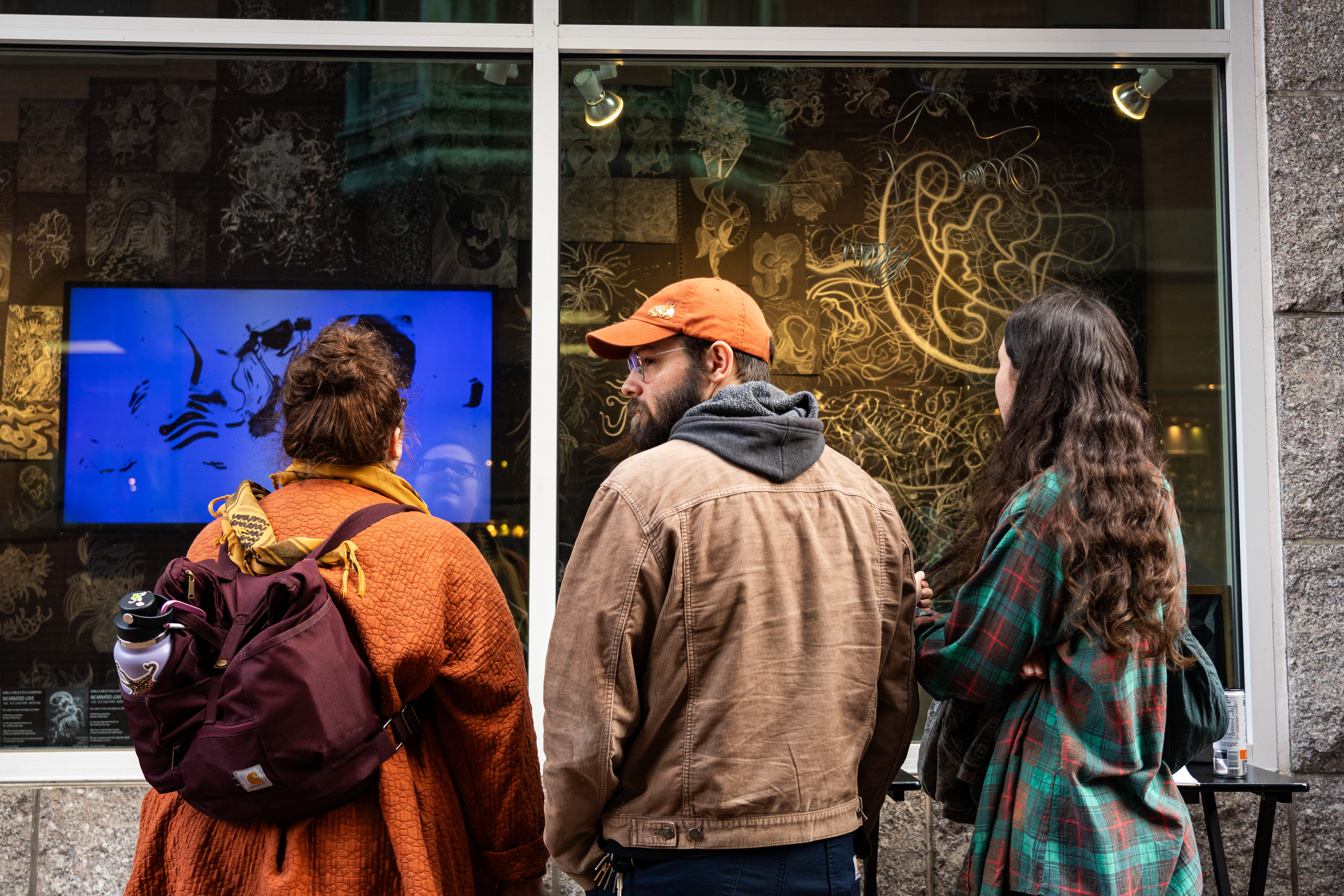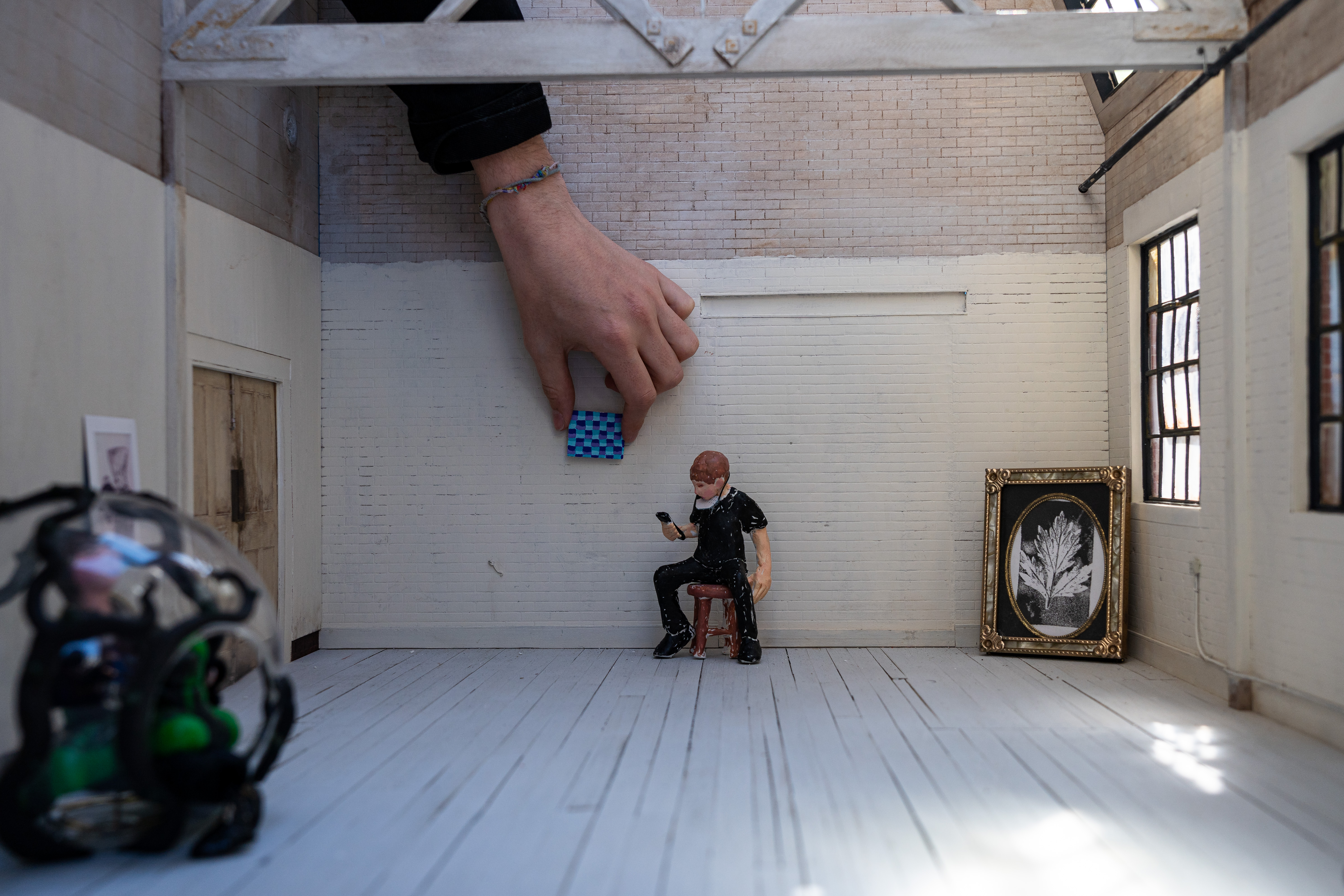About
Behind VA Shadows is an artists-run DIY public art project founded in December 2021 by a group of Visitor Assistants at the ICA,Boston. Our initiative aims to break down barriers between art and the public, showcasing the creative work of museum workers while extending accessibility beyond institutional walls. By holding the alternative space for the public to engage with the creative identity of museum workers, we advocate for communal care to counter the issues of burnout within art museums and institutions.
We are located at the corner of Mass Ave and 2 Linden St, 02138, Harvard Sq in Cambridge.
Linden St, Harvard Sq in Cambridge, MA. A.
IG
feel free to send all inquires to yolandayanghe@gmail.com
Behind Behind VA Shadows

Yolanda He Yang is a performance, installation artist and community organizer. She is the Founding Director of Behind VA Shadows since 2021.
Yolanda He Yang
she/her
Shelby Feltoon
she/her
Shelby Feltoon is an interdisciplinary artist, educator, and independent curator. Her role at Behind VA Shadows is to lead certain curatorial project and collaborate with and aid guest curators to bring their ideas to life.

Nemo Xu
she/her
Nemo Xu is a writer and an information professional in training. She is the editorial and archival lead of Behind VA Shadows. She works with artists and curators to produce exhibition content regularly and is currently working on building an archives for Behind VA Shadows.

Wenbin Huang
he/him
Wenbin Huang is a graphic designer and photographer. He works on the annual catalog design and photographic documentation of exhibitions and programming at Behind VA Shadows.
Theodora Earthwurms
they/them
Theodora “Earthwurms” Shanahan-Jewett is a multidisciplinary artist whose work centers on personal expression, gender exploration, and identity. Their volunteer work includes Horizons for Homeless Children and Big Brothers Big Sisters. Supporting community project like Behind VA Shadows aligns with their mission to increase access, visibility, and care in creative and educational spaces.
Past Shows
On My Way to Work
Group show guest-curated by Nemo Xu
August 15th, 2025 - October 5th, 2025
2 Linden St, Havard Sq, 02138

Press
Dissection of the Spector
Group show guest-curated by Patrick Brennan
June 17th, 2025 - August 13th, 2025
2 Linden St, Havard Sq, 02138

Press
Tracing the Familiar
Group show guest-curated by Clarajames Daly
May 20th, 2025 - June 15th, 2025
2 Linden St, Havard Sq, 02134

Press
Incarnated Love
Solo show by Janella Mele
April 26th, 2025 - May 20th, 2025
2 Linden St, Ha

Press
The Student Visitors
a performance and media exhibition featuring students featuring the course
“Advanced Topics in Performance and Media” at Northeastern University
Curated by Kledia Spiro
April 13th, 2025 - Apri 20th, 2025
2 Linden St, Harvard Sq in Cambridge, MA 02138

Press
After Flood
Eben Haines solo exhibition
Feburary 16, 2025 - April 10th, 2025
2 Linden St, Harvard Sq in Cambridge, MA 02138

Press
Tired Clichés
Isola Murray solo exhibition
December 14, 2024 - Feburary 4, 2025
2 Linden St, Harvard Sq in Cambridge, MA 02138

Press
To Grasp the Unattainable
Yueyang Peng solo exhibition
curated by Yolanda He Yang
November 2 - December 2, 2024
2 Linden St, Harvard Sq in Cambridge, MA 02138

Press
Straight from the Heart - The Rant Series
Julia Csekö’s solo exhibition
selected from Call for Exhibition Proposals
September 14 to October 28, 2024
2 Linden St, Harvard Sq in Cambridge, MA 02138

Press
“A Plea To The Nine Muses” Group Show
curated by Jeannie Dale
2 Linden St, Harvard Sq in Cambridge, MA 02138
July 14 - August 27th, 2024

Press
“MARGINALIA” Group Show
curated by [Working Title] and Patrick Brennan
2 Linden St, Harvard Sq in Cambridge, MA 02138
June 1st - July 4th, 2024

MARGINALIA Digital Mailbox
Press
“Night Studio” Brett Angell Solo Show
curated by Yutong Shi
2 Linden St, Harvard Sq in Cambridge, MA 02138
March 18th -May 24th, 2024

Press
“fanfare of clouds opening” Cameron Boyce x Gateway Arts
curated by Yolanda He Yang
2 Linden St, Harvard Sq in Cambridge, MA 02138
December 18th, 2023 to March 1st, 2024

Behind VA Shadows - 25/8 Artspace, Harvard Sq, Cambridge
Group Show “ten minutes worth of sand...”
curated by Shelby Feltoon
October 31 to December 1, 2023

Featuring Artists: Patrick. Brennan, Qianyue Chen, Liam Coughlin, Juliet Degree, Mariana Rey, Noelle Stillman, Jarrod White, Marjorie Williams
Press
Behind VA Shadows - 25/8 Artspace, Harvard Sq, Cambridge
Maria Servellón: “Gl{i}tch,” curated by Yolanda He Yang | September 13 - October 20, 2023

(click to view)
Art Pop : “Chairs & Cares” x Revolutionary Spaces in Old South Meeting House, Boston
curated by Yolanda He Yang | September 24th, 25th, 2023
![]()
Featuring Artists : BARD, Patrick Brennan, Shelby Feltoon, Theodora Earthwurms, Cameron Boyce, Will Weygint, Isola Murray, Ryan Ricci, Liam Coughlin, Kayla Sculli, Helena Abdelnasser, Denver Nuckolls, Working Title - L Scully, k.i.n.d.re.d- Erin Shea Hogancurated by Yolanda He Yang | September 24th, 25th, 2023
Behind VA Shadows - 25/8 Artspace, Harvard Sq, Cambridge
Nat Reed: “Bikes Move Us” curated by Yolanda He Yang | June 19 - September 14 , 2023

Artscope Online | Boston Art Review
Laconia Gallery, Boston
Group Show: “The Landscape of Our Minds” curated by Yolanda He Yang | Feburary 3 - April 16, 2023

Downtown Crossing, Boston
Group Show: “via” curated by Yolanda He Yang | June 1 - June 17, 2022

Online Group Shows

Discipline of Sleep | 1.30.23
(click to view works)
![]()
Unfolding | 11.18.22
(click to view works)
![]()
(un)Veil | 8.20.22
(click to view works)
![]()
Pockets of Belief | 4.8.22
(click to view works)
![]()
Translation - Tessellation | 3.11.22
(click to view works)
(click to view works)

Unfolding | 11.18.22
(click to view works)

(un)Veil | 8.20.22
(click to view works)

Pockets of Belief | 4.8.22
(click to view works)

Translation - Tessellation | 3.11.22
(click to view works)

Raison D'etre | 2.11.22






































































MARGINALIA mailbox.
we welcome your participation. if you would like to contribute to our exhibition, please attach one piece (image, text, animation, love note, etc) for inclusion in our digital gallery, on view for the month of June at behindvashadows.com. we invite you
to respond to the word nonessential in any format. please include a title and your name (or "anonymous") for attribution, send to vashadows@gmail.com
if you share your work on Instagram
tag us!
@working_title_boston & @behindvashadowsthank you for your messageand for becoming an artist.
When I Look at Bodies (click to view)
choral piece by Angela Yam When I Look at Bodies
text is by Anthony Rogers, a nonbinary clothing designer based in San Francisco
“ten minutes worth of sand...”
Curated by Shelby Feltoon | Instagram
Featuring
Patrick Brennan | instagram
Qianyue Chen | instagram
Liam Coughlin | instagram
Juliet Degree | instagram
Mariana Rey | instagram
Noelle Stillman
Jarrod White | instagram
Marjorie Williams | instagram | website
Featuring
Patrick Brennan | instagram
Qianyue Chen | instagram
Liam Coughlin | instagram
Juliet Degree | instagram
Mariana Rey | instagram
Noelle Stillman
Jarrod White | instagram
Marjorie Williams | instagram | website


Square Creases, Spring, 2019
analog photography
Juliet Degree

Bleeding Hearts, Summer 2020
analog photography
Juliet Degree
analog photography
Juliet Degree

Spy Pond, Summer 2018
analog photography
Juliet Degree
analog photography
Juliet Degree

Polyethylene Python, 2022
acylic on plastic
Patrick Brennan
acylic on plastic
Patrick Brennan
 Passé, 2022
Passé, 2022bisque fired ceramic clay
Patrick Brennan
 Temporal Resilience I, 2022
Temporal Resilience I, 2022Kodak UltraMax 400 Color Negative Film
Qianyue Chen

Temporal Resilience III, 2022
Kodak UltraMax 400 Color Negative Film
Qianyue Chen

Temporal Resilience II, 2022
Kodak UltraMax 400 Color Negative Film
Qianyue Chen

Birds of Paradise, 2016-2019
digital video
Jarrod White
![]()
digital video
Jarrod White

Space #2, 2022
Photograph
Noelle Stillman
![]()
Photograph
Noelle Stillman

Space #16, 2023
Photograph
Noelle Stillman
Photograph
Noelle Stillman

Con el tiempo (Overtime), 2023
Installation
Mariana Rey
Installation
Mariana Rey

untitled (expanded measure) Dimensional lumber, two Korn CDs, 21 Splenda packets, wood shims, level, clamp, cabinet speakers, amplifier,
CD player, extension cord, outlet, speaker wire, cable staples. 2023. dimensions variable.
Liam Coughlin